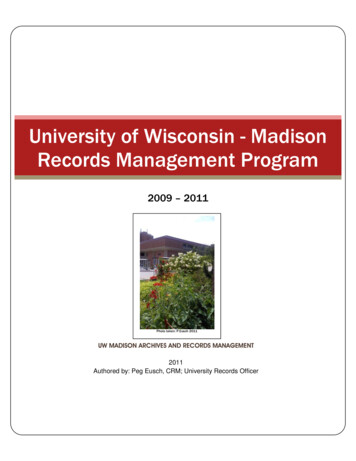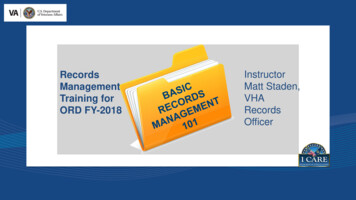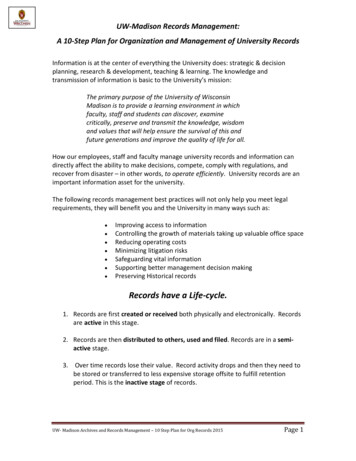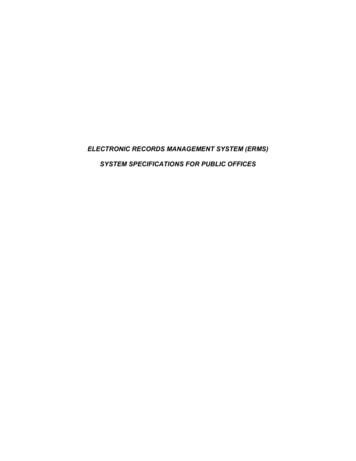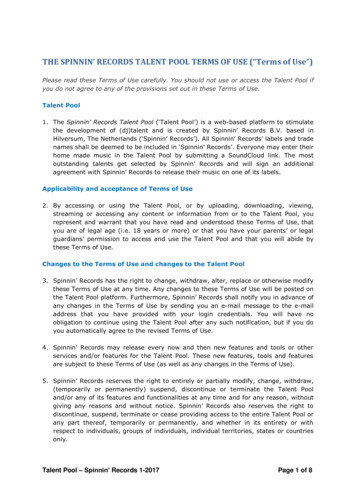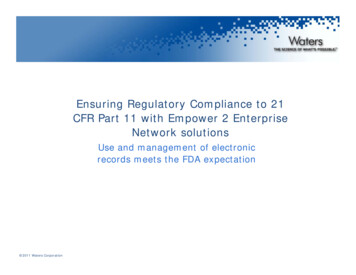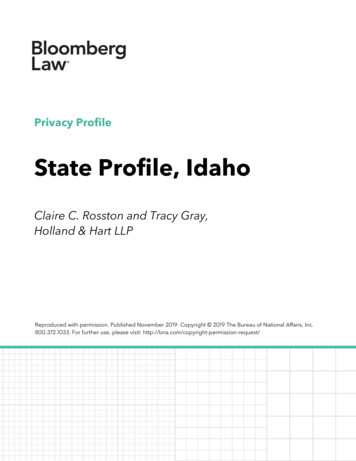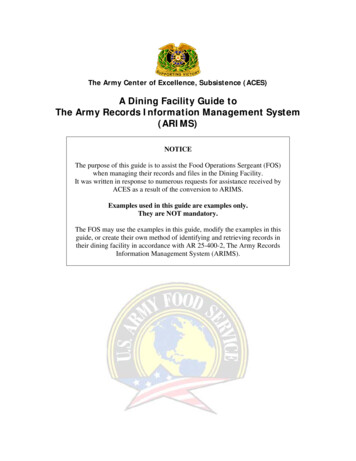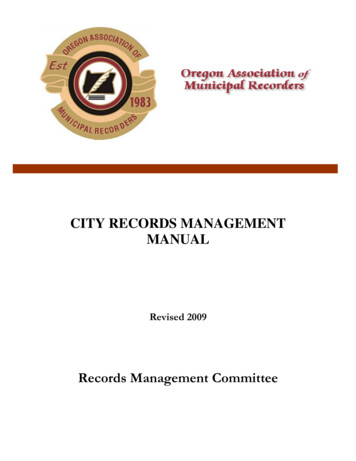
Transcription
CITY RECORDS MANAGEMENTMANUALRevised 2009Records Management Committee
“A government’s records are important resources to boththe government that creates them and to the citizens itserves. Records contain the information that keepsgovernment functioning. They document the origin, evolutionand operation of its programs. They reveal how governmentoperated, how it responded to needs and how it served itscitizens.”Program Reporting Guidelines, 1989, National Association of GovernmentArchivists and Records Administration (NAGARA)2008-09 Records Management Committee:Laurie Boyce, Aurora & Norma Alley, CMC, Newberg, Co-ChairsAlice White, JacksonvilleAmber Mathiesen, CorneliusCathy Steere, CMC, Lincoln CityCathy Wheatley, TigardDeanna Casey, MMC, Central PointDebbie Lockhart, CMC, KeizerDebbie Manning, DundeeKarin Johnson, CMC, IndependenceKim Scheafer, CMC, CanbyLinda Kaser, LebanonMary Dibble, AlbanyMelissa York, CanbyRobyn Christie, CMC, Lake OswegoSandy King, MMC, WilsonvilleTina Lynch, West Linn
CITY RECORDS MANAGEMENT MANUALTable of ContentsChapterPage NumberIntroduction . vChapter 1 - Public Records . 1General Records . 1Subpoenaed Records. 1Certifying Documents . 2Chapter 2 - Goals, Objectives and Policies. 3Program Goal . 3Objectives. 3Policies . 3Chapter 3 - City Records Managers. 5Administrative Rule. 5City Records Manager/Archivist . 5Department Records Supervisors. 5Chapter 4 - Starting A Records Management Program. 7Initial Steps In Starting A Records Management Program . 7Need Assistance?. 8Where To Start? . 8Summary . 10Chapter 5 - Life-Cycle of Records. 11Creation . 11Active Use . 11Semi-active. 11Final Disposition . 11Chapter 6 - Records Retention Schedule. 13Why Create Records Retention Schedules . 13What Are Records Retention Schedules? . 13What is a General Records Schedule?. 13What is a Special Records Schedule?. 13For Further Information. 14City Records Management Manual(Revised 2009)i
Chapter 7 - Filing Systems . 15Selecting a Filing System . 15Determining the Appropriate System. 15Types Of Filing Systems. 16Alphabetic Systems . 16Subject Systems. 17Numeric Systems . 18Geographic Systems . 20Chronological Systems. 20Establishing the Files. 21Getting Started . 21Chapter 8 - Forms Management. 23Chapter 9 - Records Storage. 25Preparing Records For Storage. 25Storage Containers. 26The Records Center - Archives . 27Chapter 10 - Records Destruction . 29Administrative Rules. 29General Records Destruction Policy. 29Records Destruction Exception Policies . 29Instructions for Records Destruction. 31Chapter 11 - Electronic Records . 33What Is An Electronic Record. 33Electronic Mail Policy and Procedure . 34Electronic Records: Access and Privacy . 36Electronic Storage Media . 38Electronic Mail . 40Legality of Electronic Records . 42Chapter 12 - Electronic Imaging. 45Oregon Revised Statutes . 45Oregon Administrative Rules . 45Available Technologies. 47Microfilming Services. 47Micrographics . 47Types of Microfilm . 47Microforms. 48Decision Making . 50For Assistance. 50City Records Management Manual(Revised 2009)ii
Chapter 13 - Records Disaster Planning . 51What Is A Records Disaster?. 51Consequences. 52What Can Be Done To Prepare?. 52What is a Records Disaster Plan? . 52What Are The Benefits Of A Records Disaster Plan?. 52What Will It Cost? . 53What Is Involved In A Records Disaster Program?. 54What Is The Planning Process? . 55Summary . 58Chapter 14 - Vital Records. 59What Are Vital Records? . 59Importance of a Vital Records Program. 59Establishing a Vital Records Program . 59Vital Records Operating Procedures . 63Summary . 63Appendix A - Networking. 65Appendix B - Glossary. 67Appendix C - Bibliography & Sources. 75Appendix D - Oregon Administrative Rules. 79Appendix E - Sample Forms. 83City Records Management Manual(Revised 2009)iii
This page intentionally left blankCity Records Management Manual(Revised 2009)iv
CITY RECORDS MANAGEMENT MANUALIntroductionThis publication was originally prepared by the Oregon Association of MunicipalRecorders (OAMR) Manual Committee and members of the State Archives staff in1990-91, updated in 1998-99, 2004-05 and 2008-09 by the OAMR RecordsManagement Committee and staff from the State Archives Division.The manual is divided into chapters including filing systems, forms management,records storage, records disposition, electronic records, microfilm, and disasterplanning. It is intended to provide basic guidelines on forming and implementing arecords management program.City Records Management Manual(Revised 2009)v
This page intentionally left blankCity Records Management Manual(Revised 2009)vi
CITY RECORDS MANAGEMENT MANUALCHAPTER 1PUBLIC RECORDSGeneral RecordsThe “Attorney General’s Public Records and Meetings Manual” published by the StateDepartment of Justice is an opinion of the Attorney General that interprets legislationpertaining to records and provides general legal advice. To purchase contact:Department of Justice, Publications Center, 100 Justice Building, 1162 Court Street NE,Salem, OR 97310, (503)378-2992, ext. #1.This manual covers the following questions related to Public Records:A.Who has the right to inspect public records?B.Who is subject to the Public Records Law?C.What records are covered by the law?D.How can a person inspect or obtain public records?1.Records Custodian2.Proper and reasonable opportunity to inspect3.Copying4.Public body prerogativesa.Protective rulesb.Feesc.Consultation with legal counseld.Destruction of public recordsE.What public records are exempt from disclosure?F.Can a public body voluntarily disclose an exempt record to selected personswithout waiving exemption generally?G.How should a person proceed if access is refused?Subpoenaed RecordsWhen an employee is served with a subpoena requiring appearance in court with anypublic record, they should immediately contact his/her legal counsel and any destructionof records should stop, even if the destruction is in the normal course of business.City Records Management Manual(Revised 2009)1
Certifying DocumentsOccasionally a request for photocopies and/or certified copies of records is madepursuant to ORS 192.430 and 192.440.If the “record copy” is in the custody of a department other than the office of the CityRecorder, the custodian of the record must certify before the City Recorder (similar to anotary) who will attest and affix the city seal. The City Recorder will certify documentsmaintained in the recorder’s office. Sample forms are contained in Appendix E. A stampstating “Certified to be a true and correct copy of the original record” with a line for theCity Recorder’s signature and name of city can also be used.City Records Management Manual(Revised 2009)2
CITY RECORDS MANAGEMENT MANUALCHAPTER 2GOALS, OBJECTIVES AND POLICIESProgram GoalTo establish an efficient and economic records program for creation, maintenance,retrieval and disposal of records.Objectives To save valuable office space by systematically removing semi-active recordsand duplicate records that are not the official record.To save money by providing low-cost storage and controlling equipmentpurchased.To identify and protect vital records (records that would be required to continueor re-establish a city’s operation following a disaster) and systematically identifythe record copy.To save time in man-hours and promote public trust by developing an orderly,efficient system for maintaining retrieving, storing, and disposing of records.Policies Store only active records in valuable office space.Move semi-active records to low-cost storage.Preserve valuable historical or archival records under adequate conditions.All valueless records shall be destroyed after meeting minimum retention andretained longer only under special circumstances.All public records, including those stored on electronic media, shall be accessibleto the public, unless exemption status is obtained.City Records Management Manual(Revised 2009)3
This page intentionally left blankCity Records Management Manual(Revised 2009)4
CITY RECORDS MANAGEMENT MANUALCHAPTER 3CITY RECORDS MANAGERSAdministrative Rule (OAR 166-030-0016)To establish a records management program insuring orderly retention and destructionof all public records and to insure the preservation of public records of value, each stateor local agency should designate a records officer to organize and coordinatescheduling records retirement, storage, and destruction.City Records Manager/Archivist: Is aware of current records laws;Maintains, monitors, and updates the city’s records retention schedule throughcoordination with the state archivist and department supervisors;Reviews requests for new records equipment and assists departments withstorage facilities;Knows current records management procedures and informs and educatesdepartments on innovations and new procedures;Develops systems for indexing historical records and assists departments withtheir systems;Assists departments in the orderly disposition of records, including destructionas authorized by the records retention schedule;Has knowledge of the most efficient and economic means of destroying records;Coordinates the microfilm program to insure proper records retention;Assists in approving storage locations for the storage of inactive and archivalrecords; andDevelops a records disaster plan.Department Records SupervisorsDepartment directors should designate one staff position as the department recordssupervisor. This person should have substantial knowledge of the operation and therecords in their department.The records supervisor should: Administer the policies and procedures of the city records management manualand any department records procedures; Supervise the disposition of records, including destruction of records meeting theminimum retention periods and the transferring of semi-active records to “low-City Records Management Manual(Revised 2009)5
cost” storage. Destruction should only be carried out with the approval of therecords officer/city recorder and department head;Assist in establishing and maintaining filing systems, standards, and proceduresfor record keeping; andServe as liaison between the department and the records officer.City Records Management Manual(Revised 2009)6
CITY RECORDS MANAGEMENT MANUALCHAPTER 4STARTING A RECORDS MANAGEMENT PROGRAMInitial Steps In Starting A Records Management Program1.The city manager or council should appoint a records officer who will beresponsible for scheduling retention and destruction of records. The city chartermay specify the City Recorder/Clerk as the Records Manager. Notify the StateArchivist of the appointment.“To establish a records management program to insure orderly retentionand destruction of all public records, and to insure the preservation ofpublic records of value, each state or local agency should designate aRecords Officer to organize and coordinate records scheduling,retirement, storage and destruction .” OAR 166-030-00162.Analyze storage needs and other capabilities including: Adequate storage for inactive records awaiting destruction. Adequate and suitable storage for “permanent” records. Microfilming as an option. Sufficient funds for a storage facility/records center. Application for grants to assist in data entry, systems design, inventories, andpreservation. Information on available grants can be found on the internet.3.Inventory to Final Disposition - This process can be accomplished through acommittee, an individual assigned in each department, or the records officer. Using a copy of the current City General Records Retention Schedule,identify records according to the schedule and mark the records with theseries title and/or number. See “Glossary” for definition of a series. Label therecord series, file cabinets, and boxes.“Unless otherwise stated, a retention period is calculated from the date thepublic record was created.” OAR 166-030-0027(2)“No public records of fiscal transactions shall be destroyed, even though therequired minimum retention period has passed, until after the required auditfor the period covered by the public records has been completed and theauditor has released the public records for destruction.” OAR 166-030-0041City Records Management Manual(Revised 2009)7
4. Separate permanent and non-permanent records. This is a good practicewhen preparing new files. See “Filing Systems” (Chapter 7, page 15). Once records have been identified, they may be stored as “inactive” recordsor destroyed in accordance with the current City General Records RetentionSchedule. See “Records Storage” (Chapter 9, page 25) and “RecordsDestruction” (Chapter 10, page 29).Records not identifiable in the General Schedule - If records do not match withthose listed in this schedule, scan surrounding record series titles anddescriptions in the most likely section for more clues. Use a records series whichmatches most closely within reasonable limits. If the city records appear to be acombination of two or more record series in the schedule, use the listing with thelongest retention period. Consult the city records officer (usually the city recorder)or the city attorney for assistance. If city records cannot be reasonablyinterpreted to match any series in this schedule, contact the State Archives forappraisal assistance or information on special records schedules.Need Assistance?OAMR website – Records Management Committee: www.oamr.orgOregon Secretary of State website: www.sos.state.or.usWhere To Start?Before a records management program can be initiated, it must be presented tomanagement and “sold” as an asset that will help the organization meet its goals.A good records management program saves manpower, office space and money.Step 1. Accumulate InformationAcquire the professional training needed to understand records management. Study thismanual, state statutes pertaining to records, the city code and charter, and recordsmanagement publications. Attend professional seminars on records issues and collectinformation to present to management. Keep a file of ideas.Determine city needs, necessary elements, expenses and limitations, manpowernecessary to support the program, and unique department issues. Visit eachdepartment, talk with records personnel, and view the records. Explain the plan to staffmembers who will assist.Armed with an understanding of retention schedules and record processing procedures,records, organization charts, files, micrographics, data processing equipment, andrecord storage/retrieval equipment can be inventoried.Collect information about: Volume of existing records Records storage/retrieval equipment and storage containersCity Records Management Manual(Revised 2009)8
Commercial microfilming services, including computer output microfilm (COM)servicesClerical, professional/technical and managerial laborElectronic mediaStep 2. Developing Goals And ObjectivesSell practical ideas that will help the city reach its objectives. Develop a clear jobdescription and/or work plan citing planned steps and goals. (See Records Manager –Chapter 3, page 5)Consider: Why is the program needed? Are goals realistic and reasonable? Do objectives and goals support city objectives and goals? What elements of a records management program already exist?Step 3. Benefits An established records management program lends credibility to citymaintenance of the public record and can be useful if records aresubpoenaed during court proceedings.In the event of a disaster a records disaster and recovery program avoidsallegations of neglect which could lead to litigation or denial of an insuranceclaim.Once identified, vital records would be protected from loss and theorganization could recover quickly in the event of a disaster.Savings could be realized by identifying and destroying duplicate documents.An efficient records management program could reduce personnel needs.Regular scheduled destruction of records eliminates the need for addedstorage and frees up space for more productive uses.Step 4. Developing The Draft PlanAssemble the program plan, develop staff assignments and schedules to propose to topmanagement. Keep the plan realistic and within reasonable time limits. Determine whichpersonnel will work full time in the records management program, which will work parttime, and which will assist.When preparing the plan, take into consideration that management views recordsmanagement primarily from a financial perspective. Also, consider preparing more thanone plan based on budgets and time availability. Include awards and fun events like“appreciation ceremonies” or a “records destruction day” with contests and prizes tomake the program enjoyable and rewarding. Keep track of the people who help andreward them. There will be more support and enthusiasm for the program if thoseinvolved are rewarded. Acknowledge everyone involved. Notify the local media.Consider starting an in-house newsletter to provide personnel with updated recordsmanagement information and education.City Records Management Manual(Revised 2009)9
Step 5. Presenting Recommendations to Top ManagementFirst distribute the proposal several days prior to the meeting date to allow sufficienttime for study and formulation of questions. Request that questions be submitted inadvance and in writing to allow adequate time for developing a response. Then presentthe program to management and those involved in order to provide a forum fordiscussion.SUMMARY Accumulate information and obtain professional training.Develop reasonable goals and objectives, an overall records program, orprogram enhancements.Identify tangible and intangible benefits.Develop a draft plan that identifies personnel requirements and a schedule forimplementing the recommendations.Present the program to top management, outlining the plan along withexpected goals and benefits.Ask for support, discuss it, and once obtained, use it to convince personnel ofthe importance of the program, its goals and policies.Once the program is successfully established, continue to promote the concept,possibilities, and benefits of records management.City Records Management Manual(Revised 2009)10
CITY RECORDS MANAGEMENT MANUALCHAPTER 5LIFE CYCLE OF RECORDSCreationInformation created in relation to public business is a public record. Public records arethe heart of government operations. These records are: Created for the citizens, The property of the citizens, Protected in the interest of citizens, Documentation of how the government serves the needs of the citizens, and Historical, legal, administrative or fiscal records.Active UseRecords in active use are stored in areas of easy access also known as “high-coststorage” areas. These records are usually no older than two years.Semi-activeRecords in this phase are needed less frequently but must be retained until the legalminimum retention has been met. These semi-active records are usually stored in “lowcost storage” areas that meet special storage conditions. Separating semi-activerecords from active records allows staff to become more efficient in maintaining andaccessing active records.Final DispositionWhen a record has served its purpose for the operation of the office, it is ready for finaldisposition. Some records are destroyed after meeting the authorized minimumretention. Other records are retained indefinitely (as permanent documents) when theyhave historical or archival value. Records retained indefinitely should be stored underspecial storage conditions.City Records Management Manual(Revised 2009)11
LIFE CYCLE OF A portsDrawingsCopiesMicroformsComputer etrieveDecision MakingDocumentationResponseReferenceLegal requirementsCity Records Management Manual(Revised 2009)12
CITY RECORDS MANAGEMENT MANUALCHAPTER 6RECORDS RETENTION SCHEDULEWhy create records retention schedules?Oregon state and local governments produce a staggering amount and variety ofrecords. Some of these records need to be kept long-term for legal, fiscal,administrative, or historical reasons. Others may be disposed of relatively quickly aftertheir usefulness has expired. Government records are an important resource both to theagency and the general public and must be managed with the same care, concern, andskill as any other key asset.What are records retention schedules?Records retention schedules are lists and descriptions of public records. They includeinformation about how long each type of record should be kept (retention period) andwhat should happen to it at the end of that period (disposition). Records retentionschedules cover records in all formats, including but not limited to paper, microfilm, andelectronic media.What is a general records schedule?A general records schedule applies to an entire group of state or local governmententities. Thus, a city general records schedule applies to the records of all cities inOregon. The only exception is if a valid "special schedule" exists for a particular state orlocal government entity or an office or record within that entity. In these cases, specialschedules override the requirements of a general schedule.The City General Records Retention Schedule can be found at http://arcweb.sos.state.or.us/rules/OARS 100/OAR 166/166 200.html What is a special records schedule?A special records schedule can be written for local governments to describe in detailcertain records unique to an individual city. These limited schedules expire five yearsafter creation. For more information, contact the State Archivist.City Records Management Manual(Revised 2009)13
For Further InformationThe records officer for the appropriate agency can answer specific questions related toa particular records retention schedule. The city recorder is typically designated as therecords officer. For further information, refer to the Records Retention SchedulesFrequently Asked Questions at mt.html Contact the Oregon State Archives for general questions about records retentionschedules or to create a records retention schedule.Oregon State Archives800 Summer Street NESalem, OR 97310(503) 373-0701http://arcweb.sos.state.or.usCity Records Management Manual(Revised 2009)14
CITY RECORDS MANAGEMENT MANUALCHAPTER 7FILING SYSTEMSSelecting A Filing SystemRecords management is intended to control recorded information from its creation untilits disposition. The ability to file and retrieve information easily and effectively is centralto this process. T
"To establish a records management program to insure orderly retention and destruction of all public records, and to insure the preservation of public records of value, each state or local agency should designate a Records Officer to organize and coordinate records scheduling, retirement, storage and destruction ." OAR 166-030-0016 . 2.
